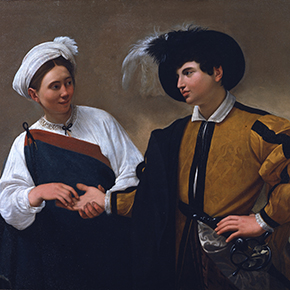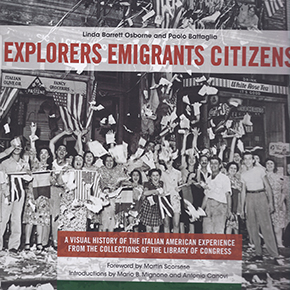This February visitors to the Muscarelle Museum of Art at the College of William & Mary will have a rare opportunity to view three famous paintings by, or attributed to, Caravaggio and take sides in an intense debate among the world’s leading authorities on Italian paintings.
Two nearly identical versions of Caravaggio’s Saint Francis in Meditation that have left experts divided. Despite years of debate, the experts are divided as to which one of these two beautiful paintings was created first… and by whom? Which one is the original? Could they both be by the great Michelangelo Merisi, called Caravaggio?
The two paintings on special loan from Rome’s Capuchin church and from the town of Carpineto Romano will be shown side by side, affording a once-in-a-lifetime opportunity for the Williamsburg audience to compare them. The exhibition will be completed by another of Caravaggio’s best-known compositions, the Fortune Teller, on loan from the Pinacoteca Capitolina in Rome. Although disputed by the experts until as recently as 1985, this painting is now recognized as a milestone in Caravaggio’s representation of daily life, not to mention a characteristic example of his style shortly after his arrival in
Rome in the early 1590s.
 At the end of the 1500s, in the same years that Shakespeare wrote Hamlet, Caravaggio painted Saint Francis in solitary dialogue with a skull. Caravaggio’s conception of the theme was so arresting that a profusion of copies were made, both during his lifetime and long afterwards. As with many of Caravaggio’s compositions, the conception of the theme was so arresting that numerous copies were made, even during his lifetime. The two competing paintings in this exhibition encapsulate the problems faced by scholars in attributing, dating and interpreting the works of the revolutionary realist, Caravaggio. Michelangelo Merisi (Milan 1571 – 1610 Port’Ercole) was known by the name of Caravaggio, the rural town in Lombardy where his family lived and worked. As an apprentice in Milan, Caravaggio ignored his contemporaries and looked instead to the Renaissance masters, Leonardo da Vinci, Giorgione and Titian, who inspired him to illustrate the Bible stories as contemporary events in recognizable settings. Perhaps Caravaggio’s greatest innovation was to portray his friends and models in his canvases, as if the ancient stories had been enacted by ordinary people under the brilliant sun of
At the end of the 1500s, in the same years that Shakespeare wrote Hamlet, Caravaggio painted Saint Francis in solitary dialogue with a skull. Caravaggio’s conception of the theme was so arresting that a profusion of copies were made, both during his lifetime and long afterwards. As with many of Caravaggio’s compositions, the conception of the theme was so arresting that numerous copies were made, even during his lifetime. The two competing paintings in this exhibition encapsulate the problems faced by scholars in attributing, dating and interpreting the works of the revolutionary realist, Caravaggio. Michelangelo Merisi (Milan 1571 – 1610 Port’Ercole) was known by the name of Caravaggio, the rural town in Lombardy where his family lived and worked. As an apprentice in Milan, Caravaggio ignored his contemporaries and looked instead to the Renaissance masters, Leonardo da Vinci, Giorgione and Titian, who inspired him to illustrate the Bible stories as contemporary events in recognizable settings. Perhaps Caravaggio’s greatest innovation was to portray his friends and models in his canvases, as if the ancient stories had been enacted by ordinary people under the brilliant sun of
Italy.
‘Caravaggio Connoisseurship: Saint Francis in Meditation and the Capitoline Fortune Teller’ includes a didactic section in which explanatory texts and photographic enlargements present the cases for the differing points of view, equipping visitors to see the works with the eyes of a connoisseur and judge for themselves. An online poll will be set up in the gallery to registrar every visitor’s vote.
An illustrated booklet with texts by John T. Spike (assistant director and chief curator of the Muscarelle Museum of Art) and Sergio Guarino (curator of the Capitoline Museum) will be available.
General Information
Caravaggio Connoisseurship: Saint Francis in Meditation and the Capitoline Fortune Teller will be on view at the Muscarelle Museum of Art, February 8-April 6, 2014. The Muscarelle Museum of Art is located at 603 Jamestown Road on the campus of William & Mary in Williamsburg, Va. For more information, call 757-221-2700 or visit www.wm.edu/muscarelle.
The exhibition will be seen at the Museum of Fine Arts, Boston, from April 12 – June 15,
2014.
Caravaggio, The Fortune Teller (ca. 1594-95): On view at the Muscarelle Museum of Art; on loan from the Musei Capitoline Pinacoteca, Rome

